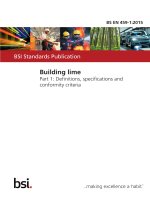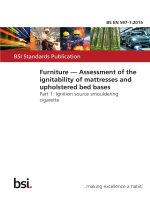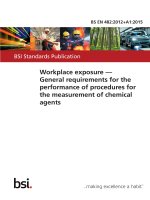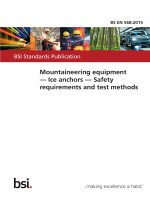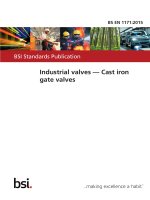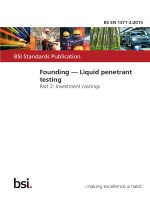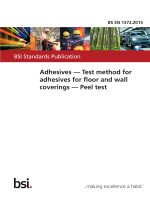Bsi bs en 16474 2015
Bạn đang xem bản rút gọn của tài liệu. Xem và tải ngay bản đầy đủ của tài liệu tại đây (1.96 MB, 76 trang )
BS EN 16474:2015
BSI Standards Publication
Plastics and rubber machines —
Tyre curing machines — Safety
requirements
BS EN 16474:2015
BRITISH STANDARD
National foreword
This British Standard is the UK implementation of EN 16474:2015.
The UK participation in its preparation was entrusted to Technical
Committee MCE/3/2, Rubber and plastics machine - Safety.
A list of organizations represented on this committee can be
obtained on request to its secretary.
This publication does not purport to include all the necessary
provisions of a contract. Users are responsible for its correct
application.
© The British Standards Institution 2015. Published by BSI Standards
Limited 2015
ISBN 978 0 580 77052 4
ICS 83.200
Compliance with a British Standard cannot confer immunity from
legal obligations.
This British Standard was published under the authority of the
Standards Policy and Strategy Committee on 30 April 2015.
Amendments issued since publication
Date
Text affected
BS EN 16474:2015
EN 16474
EUROPEAN STANDARD
NORME EUROPÉENNE
EUROPÄISCHE NORM
April 2015
ICS 83.200
English Version
Plastics and rubber machines - Tyre curing machines - Safety
requirements
Machines pour les matières plastiques et le caoutchouc Machines à vulcaniser les pneumatiques - Prescriptions de
sécurité
Kunststoff- und Gummimaschinen Reifenvulkanisiermaschinen - Sicherheitsanforderungen
This European Standard was approved by CEN on 10 October 2014.
CEN members are bound to comply with the CEN/CENELEC Internal Regulations which stipulate the conditions for giving this European
Standard the status of a national standard without any alteration. Up-to-date lists and bibliographical references concerning such national
standards may be obtained on application to the CEN-CENELEC Management Centre or to any CEN member.
This European Standard exists in three official versions (English, French, German). A version in any other language made by translation
under the responsibility of a CEN member into its own language and notified to the CEN-CENELEC Management Centre has the same
status as the official versions.
CEN members are the national standards bodies of Austria, Belgium, Bulgaria, Croatia, Cyprus, Czech Republic, Denmark, Estonia,
Finland, Former Yugoslav Republic of Macedonia, France, Germany, Greece, Hungary, Iceland, Ireland, Italy, Latvia, Lithuania,
Luxembourg, Malta, Netherlands, Norway, Poland, Portugal, Romania, Slovakia, Slovenia, Spain, Sweden, Switzerland, Turkey and United
Kingdom.
EUROPEAN COMMITTEE FOR STANDARDIZATION
COMITÉ EUROPÉEN DE NORMALISATION
EUROPÄISCHES KOMITEE FÜR NORMUNG
CEN-CENELEC Management Centre: Avenue Marnix 17, B-1000 Brussels
© 2015 CEN
All rights of exploitation in any form and by any means reserved
worldwide for CEN national Members.
Ref. No. EN 16474:2015 E
BS EN 16474:2015
EN 16474:2015 (E)
Contents
Page
Foreword ..............................................................................................................................................................4
Introduction .........................................................................................................................................................5
1
Scope ......................................................................................................................................................6
2
Normative references ............................................................................................................................6
3
Terms and definitions ...........................................................................................................................8
4
4.1
4.2
4.3
List of significant hazards ................................................................................................................. 12
General ................................................................................................................................................. 12
General hazards .................................................................................................................................. 18
Hazards associated with specific machine parts or areas ............................................................. 18
5
5.1
5.2
5.2.1
5.2.2
5.2.3
5.3
5.4
5.4.1
5.4.2
5.4.3
5.4.4
Safety requirements and/or protective measures ........................................................................... 20
General safety requirements and/or protective measures ............................................................. 20
Specific safety requirements and/or protective measures ............................................................ 21
Specific requirements for operation in production mode .............................................................. 21
Specific requirements for operations other than the production mode ....................................... 53
Specific requirements for tyre curing machines with two cavities and independent curing
cycles and independent safeguarding ............................................................................................. 54
Emergency stop function ................................................................................................................... 54
Requirements for noise reduction .................................................................................................... 54
Main noise sources............................................................................................................................. 54
Noise reduction at source by design ................................................................................................ 55
Noise reduction by protective measures ......................................................................................... 55
Information connected with noise hazards ...................................................................................... 55
6
Verification of the safety requirements and/or protective measures ............................................ 55
7
7.1
7.2
7.2.1
7.2.2
7.2.3
7.2.4
7.2.5
7.2.6
7.2.7
7.2.8
7.2.9
7.2.10
7.2.11
7.3
7.4
Information for use ............................................................................................................................. 62
General ................................................................................................................................................. 62
Instruction handbook ......................................................................................................................... 62
General ................................................................................................................................................. 62
Exhaust system................................................................................................................................... 62
Leakage of nitrogen ............................................................................................................................ 62
Hazards due to hot surfaces .............................................................................................................. 62
Leakage of curing media from hoses and pipes ............................................................................. 62
Non-permanent safe means of access ............................................................................................. 63
Maintenance operations ..................................................................................................................... 63
Fixation of the upper part of the container or mould ...................................................................... 63
Machine parameters ........................................................................................................................... 63
Emergency stop and fluid discharge ................................................................................................ 63
Noise emission.................................................................................................................................... 63
Marking ................................................................................................................................................ 64
Warning signs ..................................................................................................................................... 64
Annex A (normative) Noise test code ............................................................................................................ 65
A.1
Introduction ......................................................................................................................................... 65
A.2
Measurement of the A-weighted emission sound pressure level at the operator’s or other
specified positions ............................................................................................................................. 65
A.2.1
Basic standards .................................................................................................................................. 65
2
BS EN 16474:2015
EN 16474:2015 (E)
A.2.2
Measurement procedure ..................................................................................................................... 65
A.2.3
Measurement uncertainty ................................................................................................................... 66
A.3
Installation, mounting and operating conditions for noise emission measurement ................... 66
A.4
Information to be recorded and reported .......................................................................................... 66
A.5
Declaration and verification of noise emission values ................................................................... 67
Annex ZA (informative) Relationship between this European Standard and the Essential
Requirements of EU Directive 2006/42/EC ........................................................................................... 70
Bibliography ...................................................................................................................................................... 71
3
BS EN 16474:2015
EN 16474:2015 (E)
Foreword
This document (EN 16474:2015) has been prepared by Technical Committee CEN/TC 145 “Plastics and
rubber machines”, the secretariat of which is held by UNI.
This European Standard shall be given the status of a national standard, either by publication of an identical
text or by endorsement, at the latest by October 2015, and conflicting national standards shall be withdrawn at
the latest by October 2015.
Attention is drawn to the possibility that some of the elements of this document may be the subject of patent
rights. CEN [and/or CENELEC] shall not be held responsible for identifying any or all such patent rights.
This document has been prepared under a mandate given to CEN by the European Commission and the
European Free Trade Association, and supports essential requirements of EU Directive(s).
For relationship with EU Directive 2006/42/EC, see informative Annex ZA, which is an integral part of this
document.
According to the CEN-CENELEC Internal Regulations, the national standards organizations of the following
countries are bound to implement this European Standard: Austria, Belgium, Bulgaria, Croatia, Cyprus, Czech
Republic, Denmark, Estonia, Finland, Former Yugoslav Republic of Macedonia, France, Germany, Greece,
Hungary, Iceland, Ireland, Italy, Latvia, Lithuania, Luxembourg, Malta, Netherlands, Norway, Poland, Portugal,
Romania, Slovakia, Slovenia, Spain, Sweden, Switzerland, Turkey and the United Kingdom.
4
BS EN 16474:2015
EN 16474:2015 (E)
Introduction
This European Standard is a type C standard as stated in EN ISO 12100.
The machinery concerned and the extent to which hazards, hazardous situations and hazardous events are
covered are indicated in the scope of this European Standard.
When provisions of this type C standard are different from those which are stated in type A or B standards, the
provisions of this type C standard take precedence over the provisions of the other standards for machines
that have been designed and built in accordance with the provisions of this type C standard.
5
BS EN 16474:2015
EN 16474:2015 (E)
1
Scope
This European Standard applies to tyre curing machines having the following configuration.
—
crossing flow tyre curing machines, with two cavities with:
— common curing cycle and common safeguarding; or
— independent curing cycles and common safeguarding; or
— independent curing cycles and independent safeguarding;
—
tyre curing machines with one cavity;
—
tyre curing machines with automatic rear feeding and discharge.
The safety requirements and/or protective measures specified in this European Standard apply to tyre curing
machines for passenger vehicle tyres and truck tyres.
This European Standard does not deal with:
—
feeding system and discharge system;
—
tyre curing machines with manual loading of the green tyre into the mould and manual unloading of the
cured tyre from the mould;
—
ancillary equipment which is not an integral part of the tyre curing machine, e.g. conveying equipment;
—
exhaust systems.
This European Standard deals with all significant hazards, hazardous situations and events relevant to tyre
curing machines, when they are used as intended and under conditions of misuse which are reasonably
foreseeable by the manufacturer (see Clause 4).
It does not deal with hazards associated with falling of parts of the container or mould.
Some tyre curing machines include pressure vessels, which fall under Directive 97/23/EC [1]; this European
standard is not intended to support the Directive 97/23/EC.
This European Standard is not applicable to tyre curing machines which are manufactured before the date of
its publication as an EN.
2
Normative references
The following documents, in whole or in part, are normatively referenced in this document and are
indispensable for its application. For dated references, only the edition cited applies. For undated references,
the latest edition of the referenced document (including any amendments) applies.
EN 619:2002+A1:2010, Continuous handling equipment and systems - Safety and EMC requirements for
equipment for mechanical handling of unit loads
EN 953:1997+A1:2009, Safety of machinery - Guards - General requirements for the design and construction
of fixed and movable guards
6
BS EN 16474:2015
EN 16474:2015 (E)
EN ISO 14119:2013, Safety of machinery - Interlocking devices associated with guards - Principles for design
and selection (ISO 14119:2013)
EN 60204-1:2006, Safety of machinery - Electrical equipment of machines - Part 1: General requirements
(IEC 60204-1:2005)
EN 61496-1:2013, Safety of machinery - Electro-sensitive protective equipment - Part 1: General
requirements and tests (IEC 61496-1:2012)
EN 61496-2:2013, Safety of machinery - Electro-sensitive protective equipment - Part 2: Particular
requirements for equipment using active opto-electronic protective devices (AOPDs) (IEC 61496-2:2013)
EN ISO 4413:2010, Hydraulic fluid power - General rules and safety requirements for systems and their
components (ISO 4413:2010)
EN ISO 4414:2010, Pneumatic fluid power - General rules and safety requirements for systems and their
components (ISO 4414:2010)
EN ISO 4871:2009, Acoustics - Declaration and verification of noise emission values of machinery and
equipment (ISO 4871:1996)
EN ISO 11201:2010, Acoustics - Noise emitted by machinery and equipment - Determination of emission
sound pressure levels at a work station and at other specified positions in an essentially free field over a
reflecting plane with negligible environmental corrections (ISO 11201:2010)
EN ISO 11202:2010, Acoustics - Noise emitted by machinery and equipment - Determination of emission
sound pressure levels at a work station and at other specified positions applying approximate environmental
corrections (ISO 11202:2010)
EN ISO 11204:2010, Acoustics - Noise emitted by machinery and equipment - Determination of emission
sound pressure levels at a work station and at other specified positions applying accurate environmental
corrections (ISO 11204:2010)
EN ISO 12100:2010, Safety of machinery - General principles for design - Risk assessment and risk reduction
(ISO 12100:2010)
EN ISO 13732-1:2008, Ergonomics of the thermal environment - Methods for the assessment of human
responses to contact with surfaces - Part 1: Hot surfaces (ISO 13732-1:2006)
EN ISO 13849-1:2008, Safety of machinery - Safety-related parts of control systems - Part 1: General
principles for design (ISO 13849-1:2006)
EN ISO 13850:2008, Safety of machinery - Emergency stop - Principles for design (ISO 13850:2006)
EN ISO 13855:2010, Safety of machinery - Positioning of safeguards with respect to the approach speeds of
parts of the human body (ISO 13855:2010)
EN ISO 13856-2:2013, Safety of machinery - Pressure-sensitive protective devices - Part 2: General
principles for design and testing of pressure-sensitive edges and pressure-sensitive bars (ISO 13856-2:2013)
EN ISO 13856-3:2013, Safety of machinery - Pressure-sensitive protective devices - Part 3: General
principles for design and testing of pressure-sensitive bumpers, plates, wires and similar devices
(ISO 13856-3:2013)
EN ISO 13857:2008, Safety of machinery - Safety distances to prevent hazard zones being reached by upper
and lower limbs (ISO 13857:2008)
7
BS EN 16474:2015
EN 16474:2015 (E)
EN ISO 14122-2:2001, Safety of machinery - Permanent means of access to machinery - Part 2: Working
platforms and walkways (ISO 14122-2:2001)
EN ISO 14122-2:2001/A1:2010, Safety of machinery - Permanent means of access to machinery - Part 2:
Working platforms and walkways - Amendment 1 (ISO 14122-2:2001/Amd 1:2010)
EN ISO 14122-3:2001, Safety of machinery - Permanent means of access to machinery - Part 3: Stairs,
stepladders and guard-rails (ISO 14122-3:2001)
EN ISO 14122-3:2001/A1:2010, Safety of machinery - Permanent means of access to machinery - Part 3:
Stairs, stepladders and guard-rails - Amendment 1 (ISO 14122-3:2001/Amd 1:2010)
EN ISO 14122-4:2004, Safety of machinery - Permanent means of access to machinery - Part 4: Fixed
ladders (ISO 14122-4:2004)
EN ISO 14122-4:2004/A1:2010, Safety of machinery - Permanent means of access to machinery - Part 4:
Fixed ladders - Amendment 1 (ISO 14122-4:2004/Amd 1:2010)
CLC/TS 61496-3:2008, Safety of machinery ― Electro-sensitive protective equipment ― Part 3: Particular
requirements for Active Opto-electronic Protective Devices responsive to Diffuse Reflection (AOPDDR)
(IEC 61496-3:2008)
ISO 7010:2011, Graphical symbols — Safety colours and safety signs — Registered safety signs
3
Terms and definitions
For the purposes of this document, the terms and definitions given in EN ISO 12100:2010 and the following
apply.
3.1
tyre curing machine
machine used for vulcanisation of tyres usually comprising fixed and movable parts that can be locked
together, inside which the green tyre assumes its final shape and characteristics by the use of pressure and
heating
Note 1 to entry
See Figure 1 and Figure 2.
3.2
crossing flow
machine type in which green tyres are fed and loaded from the front and cured tyres are unloaded and
discharged from the rear
3.3
cavity
part of the machine in which the container and/or the mould and the bladder are installed
3.4
green tyre
assembly of rubber parts intended to be cured
3.5
cured tyre
tyre in its final form after vulcanisation
8
BS EN 16474:2015
EN 16474:2015 (E)
3.6
bladder
inflatable rubber component used to push the green tyre into contact with the mould while being inflated by the
curing media
Note 1 to entry:
The bladder is connected to the machine by means of the top ring and bottom ring.
3.7
bottom ring
assembly of the bottom bladder clamping plate
3.8
top ring
assembly of the top bladder clamping plate
3.9
green tyre stand
supporting element for the green tyre before loading
3.10
chuck
device for holding or gripping the green or cured tyre
3.11
movable upper part
part of the machine that is opened for loading the green tyre and unloading the cured tyre and is closed and
locked during curing
3.12
heating platen
equipment used to heat sidewalls of the mould by contact
3.13
steam dome
equipment used to heat the complete mould by direct contact with the steam
3.14
container
exchangeable equipment used to receive and heat the segments of the curing mould
Note 1 to entry:
The container is fixed to the tyre curing machine by use of screws or automatic fixation device.
3.15
mould
exchangeable equipment used to give the external shape to the cured tyre
3.16
dummy mould
subassembly representative of the mould used in industrial conditions
3.17
mould segment
movable part of the mould
3.18
semi-closed position
position of the movable upper part where the still open segments of the mould in the container touch the lower
part of the container thus preventing the risk of projection
9
BS EN 16474:2015
EN 16474:2015 (E)
3.19
feeding
manual or automatic operation to feed green tyres to the loading device
3.20
loading device
device used to pick up the green tyre and insert it into the tyre curing machine
3.21
curing cycle
period of time in which the curing process is completed, i.e. from full closing, squeezing and locking until the
pressure is dropped down
3.22
unloading device
device used to remove the cured tyre from the tyre curing machine
3.23
discharge
manual or automatic operation to remove cured tyres from the unloading device
3.24
take-away conveyor
conveyor that is an integral part of the machine and on which the unloading device deposits the cured tyres for
discharge to the rear of the tyre curing machine
3.25
spraying device
static or dynamic nozzle(s) used to treat the mould and/or the bladder with treatment fluid
3.26
distance guard
guard which does not completely enclose a danger zone, but which prevents or reduces access by virtue of its
dimensions and its distance from the danger zone, e.g. perimeter fence or tunnel guard
[SOURCE: EN 953:1997+A1:2009, 3.2.2]
3.27
enclosing guard
guard which prevents access to the danger zone from all sides
[SOURCE: EN 953:1997+A1:2009, 3.2.1]
10
BS EN 16474:2015
EN 16474:2015 (E)
Key
1
container
2
top ring
3
bottom ring
4
bladder
5
heating platen
Figure 1 — Main parts of tyre curing machines (front view)
11
BS EN 16474:2015
EN 16474:2015 (E)
Key
1
unloading device
2
take-away conveyor
3
green tyre stand
4
top ring
5
green tyre
6
loading device
7
chuck
8
movable upper part
9
cured tyre
Figure 2 — Main parts of tyre curing machines (side view)
4
List of significant hazards
4.1 General
This clause contains all the significant hazards, hazardous situations and events identified by risk assessment
as significant for this type of machinery and which require action to eliminate or reduce the risk.
For the location of hazards on crossing flow tyre curing machines, see Figure 3, Figure 4 and Figure 5.
12
BS EN 16474:2015
EN 16474:2015 (E)
For the location of hazards on tyre curing machines with automatic rear feeding and discharge, see Figure 6,
Figure 7 and Figure 8.
The numbering of hazards on Figure 3 to Figure 8 and in 4.3 corresponds to the numbering of hazards in
Table 1.
Figure 3 — Location of hazards on crossing flow tyre curing machines (front view)
13
BS EN 16474:2015
EN 16474:2015 (E)
Figure 4 — Location of hazards on crossing flow tyre curing machines (side view)
14
BS EN 16474:2015
EN 16474:2015 (E)
Figure 5 — Location of hazards on crossing flow tyre curing machines (top view)
15
BS EN 16474:2015
EN 16474:2015 (E)
Figure 6 — Location of hazards on tyre curing machines with automatic rear feeding
and discharge (front view)
16
BS EN 16474:2015
EN 16474:2015 (E)
Figure 7 — Location of hazards on tyre curing machines with automatic rear feeding
and discharge (side view)
17
BS EN 16474:2015
EN 16474:2015 (E)
Figure 8 — Location of hazards on tyre curing machines with automatic rear feeding
and discharge (top view)
4.2 General hazards
Electric shock or burns due to direct or indirect contact with live conductive parts (see 5.1).
Hazards due to malfunction of the hydraulic or pneumatic systems (see 5.1).
Hazards from high noise levels resulting for example in hearing impairment, tiredness, stress, loss of balance
or awareness, interference with speech communications or with the perception of acoustic signals (see 5.4).
Hazards due to neglecting ergonomic principles, e.g. musculoskeletal disorders due to posture, efforts and/or
repetitive activity related to manual feeding of green tyres (see 5.1).
4.3 Hazards associated with specific machine parts or areas
The significant hazards associated with specific parts or areas of tyre curing machines are the following:
18
BS EN 16474:2015
EN 16474:2015 (E)
1)
Crushing, shearing and/or entanglement due to closing of the movable upper part;
2)
Crushing, shearing, entanglement and/or impact due to opening of the movable upper part;
3)
Crushing due to unexpected falling of the movable upper part when it is in the fully open position;
4)
Crushing due unexpected gravity fall of the movable upper part when it is in any raised position;
5)
Crushing and/or shearing due to locking of the movable upper part;
6)
Crushing and/or shearing due to unlocking of the movable upper part;
7)
Crushing, shearing and/or impact due to downward movement of the loading device and/or green tyre
stand;
8)
Crushing, shearing and/or impact due to upward movement of the loading device and/or green tyre stand;
9)
Crushing, shearing and/or impact due to rotation of the loading device (chuck type);
10) Crushing, shearing and/or impact due to unexpected gravity fall of the loading device when it is in raised
position;
11) Crushing, shearing and/or impact due to downward movement of the unloading device;
12) Crushing, shearing and/or impact due to upward movement of the unloading device, rotation of the chuck
type unloading device or swivelling of the fork type unloading device;
13) Crushing, shearing and/or impact due to unexpected gravity fall of the unloading device when it is in
raised position;
14) Cutting, crushing and/or impact due to expansion/collapse of the chuck elements of the loading device;
15) Crushing and/or shearing due to downward and upward movement of the bottom ring;
16) Crushing and/or shearing due to downward and upward movement of the top ring;
17) Cutting, crushing and/or impact due to expansion/collapse of the chuck elements of the unloading device;
18) Crushing and/or cutting due to movement to create/release the squeeze force;
19) Crushing and/or shearing due to movement of the automatic container locking and unlocking system;
20) Crushing, shearing and/or trapping due to closing movement of the mould segments;
21) Bursting and/or ejection of materials or steam due to pressure to the bladder when the tyre curing
machine is above the semi-closed position;
22) Bursting and/or ejection of materials due to pressure to the bladder when the tyre curing machine is
below the semi-closed position;
23) Bursting and/or ejection of materials due to pressure to the bladder when the tyre curing machine is
closed and locked;
24) Bursting ejection of materials, impact, injection and/or burns due to high pressure inside the dome before
unlocking;
19
BS EN 16474:2015
EN 16474:2015 (E)
25) Bursting, ejection of materials, impact, injection and/or burns due to high pressure inside the bladder
before unlocking;
26) Bursting, ejection of materials, impact, injection and/or scalds, due to accumulation of hot water under
pressure between the bladder and tyre in case of a leakage of the bladder (only for machines using hot
water as curing media);
27) Scalds due to accumulation of hot water between the bladder and the tyre or mould;
28) Inhalation of substances hazardous to health due to release of fumes;
29) Asphyxia due to leakage of nitrogen from pipes;
30) Impact, crushing and/or cutting due to movement of power operated guards on tyre curing machines with
automatic rear feeding and discharge;
31) Burns due to hot parts (pipes, mould, heating platens, hoses, valves, etc.);
32) Scalds, burns and/or impact due to rupture of flexible hoses or failure of rigid pipes feeding curing media
to the tyre curing machine;
33) Scalds due to leakage from flexible hoses or rigid pipes feeding curing media to the tyre curing machine;
34) Crushing and/or impact due to falling of the upper part of the container;
35) Projection of fluid and/or impact due to movement of the spraying jib, if any and/or inhalation of toxic
substances released from the spraying device;
36) Fall from working positions at height;
37) Projection of fluid and/or burns due to residual pressure of curing media inside pipework;
38) Impact and/or crushing due to falling of the green tyre from the loading device or cured tyre from the
unloading device.
5
Safety requirements and/or protective measures
5.1 General safety requirements and/or protective measures
Machinery shall comply with the safety requirements and/or protective measures of this clause. In addition,
the machines shall be designed according to the principles of EN ISO 12100:2010 for relevant but not
significant hazards, which are not dealt with by this document.
Safety distances for fixed distance guards and machine parts acting as fixed guards shall comply with
EN ISO 13857:2008. For the hazard “reaching over protective structures”, if not otherwise specified in the
relevant subclauses, Table 2 shall be applied for crushing and shearing hazards, otherwise Table 1 may be
used. For reaching through openings, Table 3 and Table 4 shall be used.
Guards shall be designed and manufactured in accordance with EN 953:1997+A1:2009. Interlocking devices
shall comply with EN ISO 14119:2013. The choice between interlocking guards and interlocking guards with
guard locking shall comply with EN ISO 14119:2013, Clause 7 and EN ISO 13855:2010, Clause 9.
Interlocking guards may be power operated on tyre curing machines with automatic rear feeding and
discharge.
Light curtains shall be in accordance with EN 61496-1:2013 and EN 61496-2:2013.
20
BS EN 16474:2015
EN 16474:2015 (E)
Scanners shall comply with CLC/TS 61496-3:2008.
Light curtains and interlocking guards without guard locking shall be positioned in accordance with
EN ISO 13855:2010.
Opening an interlocking guard or actuating a protective device shall stop any dangerous movement for which
the safeguard is installed before the dangerous moving part can be reached but shall not interrupt the curing
process when the tyre curing machine is closed and locked.
The safety related parts of the control system shall be designed in accordance with EN ISO 13849-1:2008.The
required performance level (PLr) for each safety function is specified in the relevant subclauses taking into
account the risk assessment.
The electrical equipment shall be in accordance with EN 60204-1:2006.
The hydraulic equipment and its components shall be designed in accordance with EN ISO 4413:2010.
The pneumatic equipment and its components shall be designed in accordance with EN ISO 4414:2010.
Power operated take-away conveyors shall be in accordance with EN 619:2002+A1:2010.
Ergonomic principles (see EN 1005-3:2002+A1:2008 and EN 1005-4:2005+A1:2008) shall be taken into
consideration for the design of green tyre stands in case of manual feeding.
For tyre curing machines which include pressure equipment, the manufacturer shall consider the forces
resulting from the pressurization for the calculation of the mechanical strength of machine parts subjected to
these forces. See also Table 1, hazards 21 to 25.
5.2 Specific safety requirements and/or protective measures
5.2.1
5.2.1.1
Specific requirements for operation in production mode
Protection against hazards associated with specific machine parts or areas
Safety requirements and/or protective measures for operation in production mode are given in Table 1 for
crossing flow tyre curing machines and for tyre curing machines with automatic rear feeding and discharge.
The lines of Table 1 are related to the respective significant hazards listed in 4.3.
In Table 1, the safety requirements and/or protective measures are specified for the front, rear and side
positions on the tyre curing machine. Figure 9 and Figure 10 show these positions.
21
BS EN 16474:2015
EN 16474:2015 (E)
Key
Key
1
front position
1
front position
2
rear position
2
rear position
3
side position
3
side position
Figure 9 — Positions on crossing flow tyre
curing machines
Figure 10 — Position on tyre curing machine with
automatic rear feeding and discharge
.
22
EN 16474:2015 (E)
Table 1 — Safety requirements and/or protective measures for tyre curing machines in production mode (1 of 30)
Hazard
N°
Dangerous
situation
Significant
hazard(s)
Position/
location
Tyre curing machines with automatic rear feeding and
discharge
Crossing flow tyre curing machines
Safeguards and/or protective measures
PLr
Safeguards and/or protective measures
Scanner
or
Light curtain
or
Combination of fixed distance guards and machine
parts acting as fixed guards preventing access.
1
Crushing
Closing of the
Shearing
movable upper part
Entanglement
Where these safeguards cannot be practically
implemented, e.g. due to lack of space, pressure
sensitive bumpers in accordance with
EN ISO 13856-3:2013 may be installed under the
Position 1: following conditions:
—
the pressure sensitive bumper shall be
front
dimensioned and positioned so that the
dangerous moving part has stopped before
any injury can occur and that nobody can
stand between the pressure sensitive bumper
and crushing/shearing points;
—
if the pressure sensitive bumper is adjustable,
its safe position with respect to the size of the
container and mould shall be detected by the
safety related parts of the control system of
the machine before the movement can be
started.
Fixed distance guard
Position 2: and/or
Take-away conveyor, acting as a fixed distance
rear
guard.
Fixed distance guard and interlocking guard with or
without guard locking
Position 3:
or
side
Combination of fixed distance guards and machine
parts acting as fixed guards preventing access.
PLr
d
Interlocking guard with or without guard locking.
for the
safeguarding
function
c
d
only for the
stopping
function of
the
downward
movement
in case of
use of the
Interlocking guard with guard locking for the interlocking
guard with
feeding/discharge system
and/or
guard
Interlocking guard without guard locking associated
locking
with light curtains.
Fixed distance guard.
23
